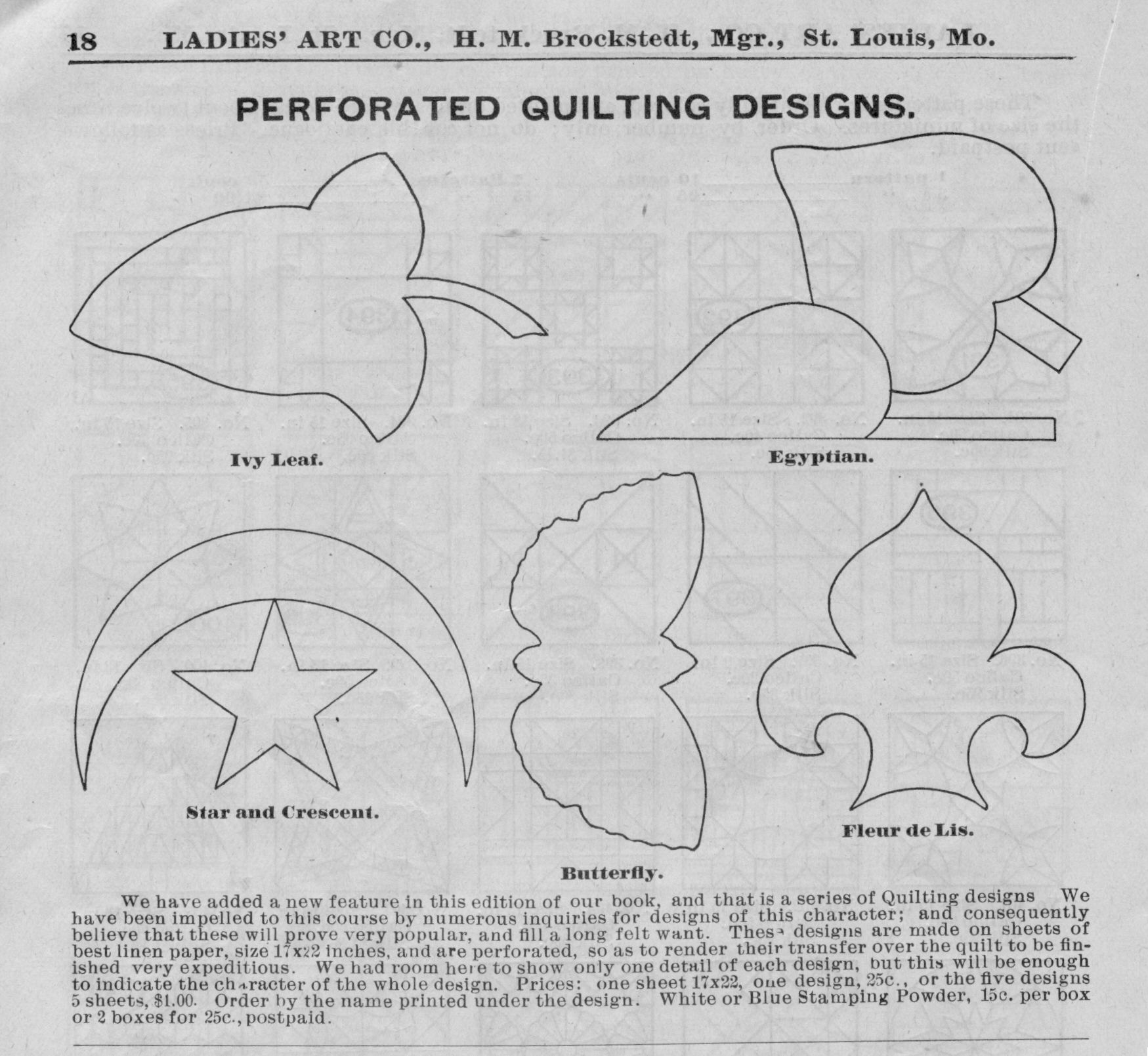Webster’s 1915 Dictionary defined the verb to quilt as “To stitch or to sew together at frequent intervals in order to confine in place the several layers of cloth and wadding of which a garment, comforter, etc., may be made. To stitch or sew in lines or patterns.” (1)
 Ladies Art Company used a very high quality of bond paper for their perforated patterns; advertising them as lasting indefinitely. At first, stamping powder or stamping wax was used to transfer the quilting designs to the quilt top. “It is best to use the powder for stamping articles to be quilted, as any part of the outline not covered by the stitches can be rubbed off with a clean cloth without marring the work.” (2) In later catalogs, Ladies’ Art Company recommended implementing tracing paper to successfully mark your quilt. Sometimes customers glued the quilting pattern directly to cardboard and then cut out along the perforated lines, using this as their quilting pattern.
Ladies Art Company used a very high quality of bond paper for their perforated patterns; advertising them as lasting indefinitely. At first, stamping powder or stamping wax was used to transfer the quilting designs to the quilt top. “It is best to use the powder for stamping articles to be quilted, as any part of the outline not covered by the stitches can be rubbed off with a clean cloth without marring the work.” (2) In later catalogs, Ladies’ Art Company recommended implementing tracing paper to successfully mark your quilt. Sometimes customers glued the quilting pattern directly to cardboard and then cut out along the perforated lines, using this as their quilting pattern.
 (Click here to see the entire original document.)
(Click here to see the entire original document.)
LAC offered to stamp the quilting design on your quilt and then finish the quilt. “Write to us for our prices on quilting. We will be pleased to quote you prices on plain or fancy quilting for any size quilt. All our quilting is hand quilting, done by experts, and we guarantee it to be first class. Only one quilter works on a single quilt, this making the stitches uniform. We shall be glad to give your inquiry, regarding, quilting, our very prompt attention.” (3)
Ladies’ Art Company sold perforated quilting designs in their catalogs. As early as the Eighth Revised Edition (c. 1901) of the Diagrams of Quilt, Sofa and Pin Cushion Patterns catalog, five quilting designs were introduced on page 18. Their quilting designs were advertised for sale in magazine ads, too.
Ladies Art Company sold just about every style of quilting pattern you might need, including whole cloth quilting patterns.
Some of the LAC quilting designs were also sold as quilt block patterns.
Q1 = No. 303, Four Little Birds
Q2 = No. 116, Philadelphia Beauty
Q3 = No. 69, Tea Leaf
Q4 = No. 416, Fleur de Lis
Q5 = No. 306, Four Points
Q6 = No. 184, California Rose
Q8 = No. 186, Mexican Rose
Q16 = No. 325, Princess Feathers
Q18 = No. 218, Compass
Q19 = No. 217, An Odd Pattern
Q21 = No. 356, The Snail’s Trail
Q20 = No. 73, The Sunflower
Q22 = No. 299, The Two Doves
Loose flyers advertising quilting patterns and quilt frames, were mailed with catalog orders. In the late 1930s, Ladies Art Company would send a free quilting design with the purchase of their catalog of stamped quilts.
This peacock quilt and quilting design are a fine example of the pattern and the final product.

 Peacock Quilt Pattern, No. Q93.
Peacock Quilt Pattern, No. Q93.
Both images are from the collection of Connie Chunn.
(1) Webster, Marie D., QUILTS, Their Story and How to Make Them, 1915. New edition with note and bibliography by Rosalind Webster Perry. Santa Barbara, California: Practical Patchwork, 1990.
(2) Catalog of Quilts and Quilting, Ladies’ Art Company, circa 1920, pg 16. (Quilt Kit No. 6076 – Old-Fashioned Bouquet is advertised on the front cover.)
(3) Catalog of QUILTS, QUILTING and HOUSEHOLD DECORATION, Ladies Art Company, circa 1928, pg 24. (Peacock Candlewick Spread, No. 7030, is advertised on the front cover.)
Copyright 2014– Connie Chunn
